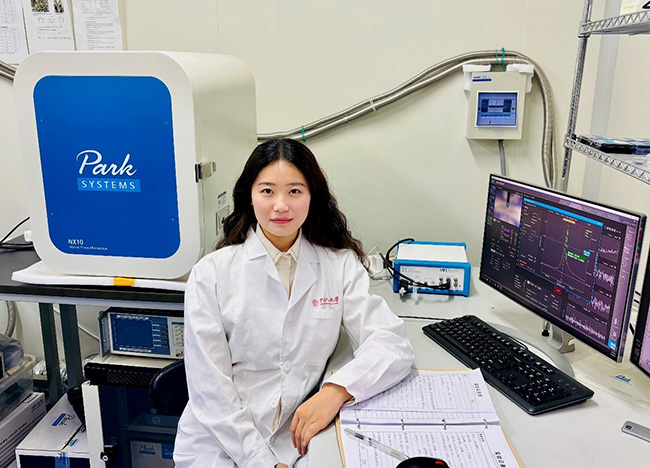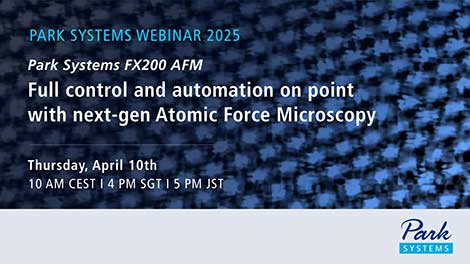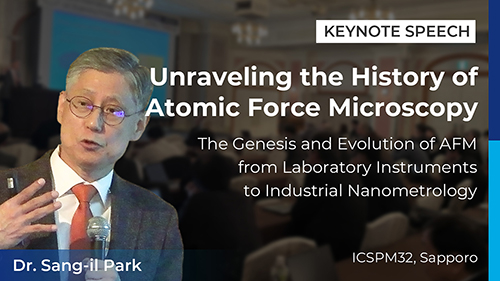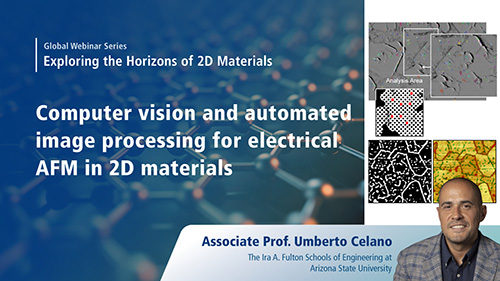
The fourth recipient of the 2024 Park AFM Scholarship is Dr. Shuo Mi, a Ph.D. candidate in the School of Physics at Renmin University of China, working in the Low-Dimensional Quantum Materials and Scanning Probe Microscopy Group, led by Professor Zhihai Cheng. Dr. Mi's research focuses on exploring the electrical and magnetic properties of two-dimensional materials using atomic force microscopy (AFM), with particular emphasis on topological spin structures and their controllable manipulation. During her doctoral studies, she was selected for the “Qiushi Academic - Dongliang” Talent Cultivation Project at Renmin University of China in 2024 and has published three first-author papers in internationally recognized journals such as Nano Letters and Nanoscale.
Dr. Shuo Mi’s latest research work, titled "Real-space Topology-Engineering of Skyrmionic Spin Textures in a van der Waals Ferromagnet Fe3GaTe2" (DOI: 10.1021/acs.nanolett.4c04031), was published in the journal Nano Letters.
In this study, Dr. Shuo Mi employed the magnetic force microscopy (MFM) technique using the Park AFM NX10 system to achieve high-precision manipulation of skyrmions in a two-dimensional ferromagnet of Fe3GaTe2. By carefully adjusting the stray magnetic field of the MFM tip, the controllable creation and erasure of individual skyrmions were successfully realized. Notably, this work achieved the construction of the coexistence state of skyrmions with topological charges of opposite polarity (S = ±1), forming topological skyrmion junctions (TSJs). This technique provides a new form of binary bit representation through the controlled coexistence of skyrmions with opposite topological charges, offering a novel design strategy for topological spin textures in skyrmion-based memory devices and enabling further exploration of spin-dependent transport phenomena in spintronics.
1. Please summarize the research you do and explain why it is significant?
Magnetic skyrmions, due to their nanometric scale, exotic magnetoelectronic properties and stable topological spin configurations, have emerged as promising candidates for future spintronic devices. The controlled generation of skyrmions with different topological charges can provide additional degrees of freedom for encoding binary data bits, which is crucial for enhancing the performance of topology-based spintronic devices. However, to date, no feasible local modulation method has been reported. If local modulation of the topological order of skyrmions can be achieved, unprecedented heterostructures of skyrmions could be realized. This unique magnetic structure may exhibit unexpected electrical properties, thereby advancing development of spintronics.
Here, we demonstrate success manipulation of skyrmions in 2D ferromagnet Fe3GaTe2 flake using magnetic force microscopy under external magnetic fields at room temperature, achieving unprecedented spatial resolution and control. In addition to achieving local controllability in the painting and erasing of skyrmions, we have also successfully demonstrated the ability to selectively write skyrmions with different topological charges. The utilization of this painting technique enables the construction of intricate patterns to accomplish diverse functionalities. Especially, the topological skyrmion junctions (TSJs) with specific configurations have been achieved by tailoring skyrmion lattices with topological charges of opposite polarity (S = ±1). The interplay of TSJs and spin-polarized current was phenomenally discussed via the in-situ transport measurements of reconfigurable TSJ device, alongside the topological stability of TSJs. The results directly demonstrate that these artificially tailored skyrmionic spin textures can locally control the motion of charge carriers in Fe3GaTe2-based spintronic devices, and further serves as the consistent magnetic layer of heterostructural devices via proximity effect.
These results not only provide a new form of binary bit representation for storage devices, but also drive the progress of spintronics and exploration of topological quantum states. Moreover, our work highlights the potential of Fe3GaTe2 as a platform material for room-temperature skyrmion-based spintronic devices, offering promising opportunities for developing Fe3GaTe2-based heterostructures with tailored topological spin textures.
2. How might your research be used?
The successful demonstration of coexisting skyrmions with topological charges of opposite polarity (S = ±1) through MFM-based local manipulation not only advances fundamental research but also enables concrete technological innovations. The S = ±1 skyrmions creates an ideal platform for binary information storage, while their topological protection ensures data stability. The efficient transport properties of these magnetic quasiparticles could revolutionize memory architecture by enabling racetrack memory devices with unprecedented density and speed.
Beyond conventional data storage, our findings will open new avenues for quantum technologies. The ability to create spatially controlled periodic magnetic fields allows for quantum material engineering, Moiré material design, and topological superconductivity, which will approach broader applications in spintronic logic devices, neuromorphic computing or quantum sensing.
3. Why is the Park AFM important for your research?
The Park AFM plays an essential role in our research, as it offers the high-resolution magnetic imaging and precise tip-sample interaction control required for skyrmion manipulation at the nanoscale. Our work focuses on the ability to locally create, erase, and reconfigure skyrmions with topological charges of opposite polarity (S = ±1) in two-dimensional ferromagnets. These operations critically depend on accurately tuning the magnetic stray-field interaction between the tip and sample under external magnetic fields, which demands superior mechanical and electronic stability. The Park AFM enables us to perform these delicate manipulations with reliable reproducibility, making it not just a characterization tool but a powerful platform for magnetic nanostructure engineering.
4. What features of Park AFM are the most beneficial and why?
Park AFM’s advanced magnetic force microscopy (MFM) capabilities, particularly its stable and precise lift-mode imaging, are essential for our research. MFM allows for high-sensitivity detection of magnetic domain structures and has been extensively used to characterize nanoscale magnetic properties. In our measurements, lift mode is critical:
- In the first scan, the tip scans in non-contact mode to obtain the topography of the sample surface.
- In the second scan, the tip is lifted to a set height where it is only influenced by long-range magnetic forces, isolating the magnetic signal from surface topography effects.
Crucially, during the first scan, we adjust the setpoint value and external magnetic field precisely to enhance the interaction between the magnetic stray fields of the tip and the sample. Thereby we reach the conditions required for cutting the labyrinthine domains and enabling targeted magnetic domain modulation. The subsequent MFM images performed in the second scan at a greater tip-sample distance confirms the controllable transition from labyrinthine domains to skyrmion states.
Low-Dimensional Quantum Materials and Scanning Probe Microscopy Research Group
(Cheng Zhihai Research Group, Renmin University of China)
The Low-Dimensional Quantum Materials and Scanning Probe Microscopy Group at Renmin University of China, led by Professor Zhihai Cheng, focuses on the forefront of research in low-dimensional quantum materials and devices, surface/interface physics, and advanced scanning probe microscopy techniques.
Our main research directions include:
1. Development of advanced and functional scanning probe microscopy technique.
2. Chemical vapor deposition and property engineering of low-dimensional quantum materials.
3. Investigation of atomic-scale structures and their mechanical, electrical, and magnetic properties.
Contact:
Email: zhihaicheng@ruc.edu.cn
Website: http://spm.phys.ruc.edu.cn




